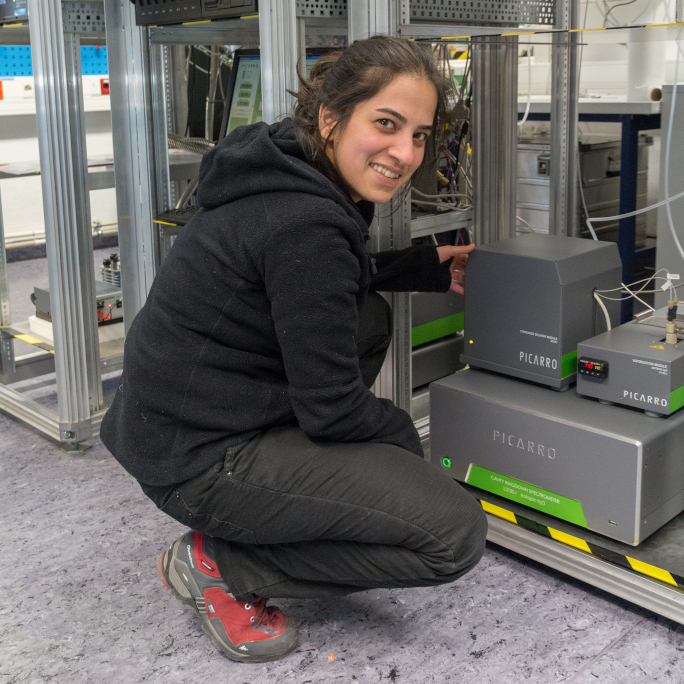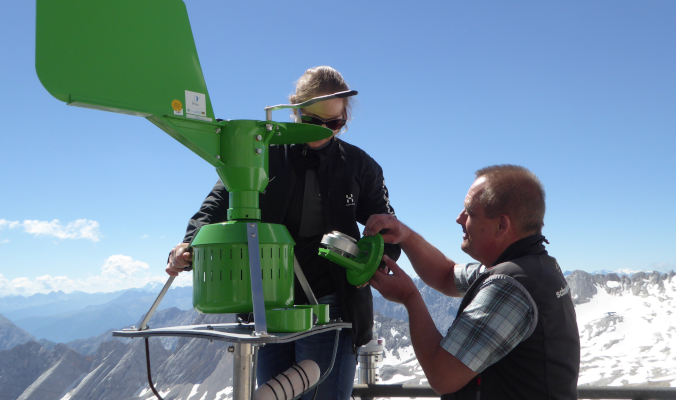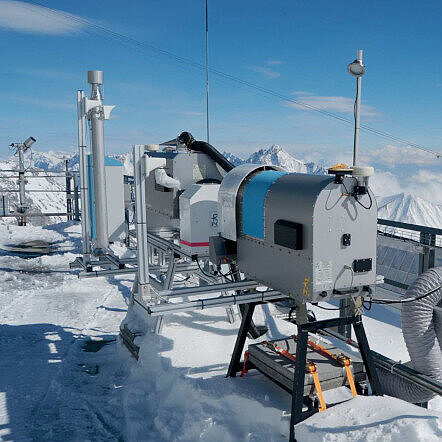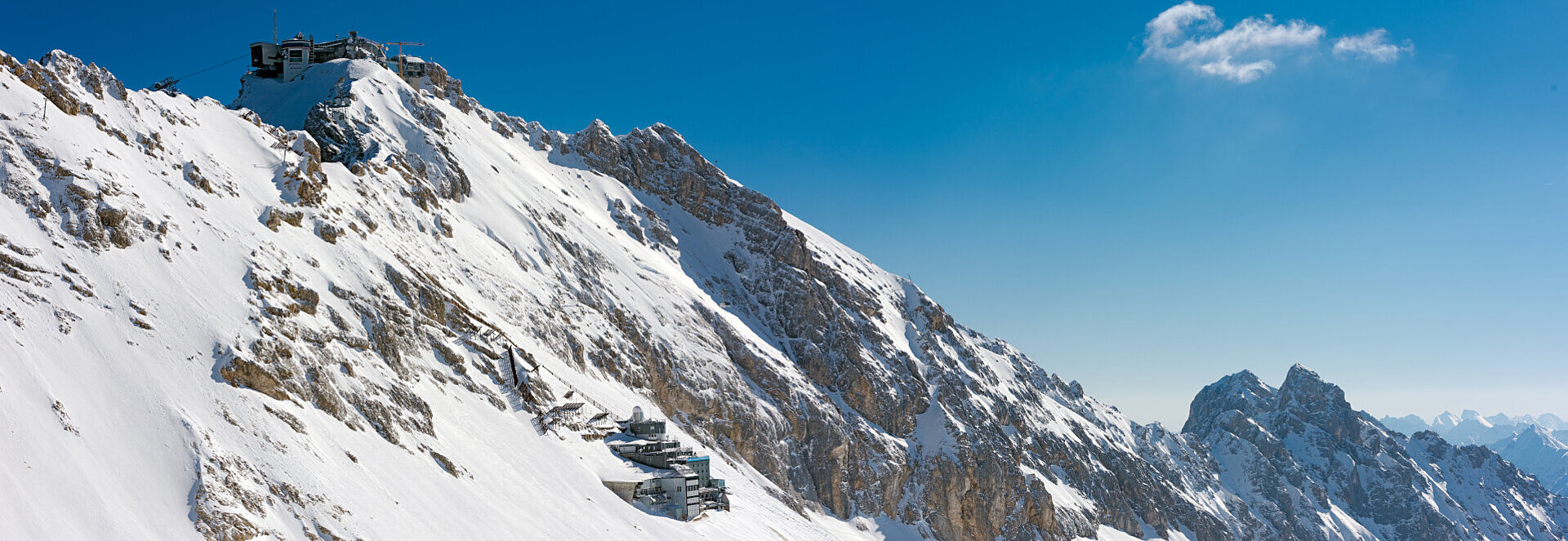Climate Research with a Breathtaking View
When working on her PhD, Homa Ghasemifard didn’t only go into the lab or the library; her most important journey to work took her by cable car up the highest mountain in Germany. She collected her research data on the southern side of the Zugspitze, at the Environmental Research Station Schneefernerhaus (UFS) 2,650 meters above sea level.
Even on the way up, it is clear that the station is anything but a usual place for research: “In the morning the cable car is often empty, and so you’re standing there alone with mountains around you and the lake Eibsee below,” says Ghasemifard. “The peacefulness of the place is really special for me; it’s so quiet up there.” Every few weeks she traveled up to the Zugspitze to do maintenance for a couple of instruments, taking the first cable car that left for the summit in the morning.


Catching Traces of CO2 Pollution in the Crisp Alpine Air
When Ghasemifard submitted her thesis at the Technical University of Munich (TUM) earlier this year, she sadly also said farewell to the Schneefernerhaus. “It’s the most beautiful office or laboratory you can work in,” says Ghasemifard, “with this spectacular view, in different kinds of weather conditions. When I’m there, it feels like I’m the luckiest scientist on earth right now.”
In the crisp alpine air, the data she was looking for were traces of carbon dioxide pollution that had traveled with the wind over hundreds of kilometers—data for her PhD with TUM’s ecoclimatology research group headed by Prof. Annette Menzel. The renowned professor, and Ghasemifard’s PhD supervisor, was one of the lead authors of the fourth assessment report of the Intergovernmental Panel on Climate Change (IPCC), which received the Nobel Peace Prize in 2007.
We definitely have to worry. Temperatures here in the Alpine region have already risen by over two degrees. That is … much more than the global average.Prof. Dr. Annette Menzel, Professor of Ecoclimatology, Technical University of Munich
Ghasemifard joined the research group having completed a master’s in environmental physics at the University of Bremen and her undergraduate studies in physics in her home city of Tehran, Iran. For her PhD research, Ghasemifard also benefitted from working with another group at TUM: she spent a year as a guest scientist with the team led by Jia Chen, urban greenhouse-gas and air-pollution specialist and professor of environmental sensing and modelling. Through this experience, Ghasemifard not only gained insights for her project in another discipline, but also published a couple of papers in collaboration with Chen and her PhD students. Before finishing her own PhD, she thus co-authored several papers both with Menzel and Chen and their groups.

Where in Europe Did This Atmospheric CO2 Come From?
With her data from the Zugspitze, Ghasemifard tracked down sources of anthropogenic pollution with the greenhouse gas CO2 north of the Alps, thus providing new insights into the geographical distribution of sources and sinks of atmospheric CO2—data that are much needed to better understand climate change. Using models of how air masses travel, she was able to identify their sources: coal-mining areas in eastern Germany, and the industrial regions of northwestern Europe, such as the Netherlands and the German Ruhr Area. Specific isotope signatures had also identified that part of the recorded pollution events are emissions from local sources, such as residential wood burning, mainly in the villages in the Alpine area.
Ghasemifard’s supervisor Prof. Annette Menzel is investigating the interactions of atmosphere and biosphere. Through her research, she has gained detailed insights on the effects of global warming – effects that are already dramatically influencing the sensitive ecology and environment of the Alps. “We definitely have to worry,” Menzel said in a 2019 TV documentary for German public broadcaster ARD. “Temperatures here in the Alpine region have already risen by over two degrees. That is much more than in the lowlands, and also much more than the global average. The forecasts are pointing in the same direction, too: Warming will increase even more strongly here than in non-alpine areas. As a consequence, the natural environment will experience massive changes, reaching from the glaciers and forests to hydrology and water supply.”
Where Leading Institutions Work Together in Environmental Research
At the Environmental Research Station Schneefernerhaus, Annette Menzel is part of the science team and speaker for the scientific activities concerning research on the biosphere and geosphere—but this is far from the only topic pursued up here. Several leading German universities and research institutions share the station, which belongs to the Free State of Bavaria, in order to pursue a diverse range of questions in interdisciplinary research areas such as regional climate and atmosphere, satellite-based observations and early detection, cosmic radiation and radioactivity, hydrology, environmental and high-altitude medicine, global atmosphere watch, biosphere and geosphere, as well as cloud dynamics. The station is also open to new research areas, as long as they do not influence the ongoing measurements, and also welcomes other institutions to conduct their research up at the Schneefernerhaus.


The technical staff (Betriebsmannschaft) that runs and maintains the Schneefernerhaus have been very supportive of Ghasemifard and previous members of the professorship of ecoclimatology who were responsible for various instruments. “I worked with a number of different devices—and when at some point something would break down, and my colleagues and I were not able to fix it remotely, they were always there,” she says. “They are really nice, helpful, and supportive, and I learned a lot from them.”
From Luxury Hotel to Research Station
What used to be Germany’s highest hotel is now one of its leading environmental research stations: the Schneefernerhaus on the sunny southern face of the Zugspitze, the country’s highest mountain. It opened as a luxury hotel in 1931, boasting a view of the northernmost glaciers of the Alps: the Southern and Northern Schneeferner glaciers. It closed in 1992, the same year that the Rio Earth Summit addressed the issue of climate change for the first time—and 172 nations signed up to the UN Climate Change Convention. As a result, the former hotel on the Zugspitze was turned into modern research station that opened in 1999. (Read more about the exciting history of the Schneefernerhaus.)
The station is owned by the Bavarian State Ministry of the Environment, but also partly financed by the local councils of Grainau and Garmisch-Partenkirchen. Today these ten leading German research institutions together form a virtual institute at the Environmental Research Station Schneefernerhaus (UFS)—to do research at the highest level:
- German Aerospace Center (DLR)
- Karlsruhe Institute of Technology (KIT)
- Helmholtz Zentrum München – German Center for Environmental Health
- DWD - Germany’s National Meteorological Service (Deutscher Wetterdienst)
- German Environment Agency (Umweltbundesamt)
- Technical University of Munich
- Ludwig-Maximilians-Universität München
- University of Augsburg
- Max Planck Society
- The State of Bavaria represented by the Landesamt für Umwelt
Meeting Great People—and Widening Your Horizon
Getting to know many different instruments, as well as meeting scientists from so many disciplines and research institutions, is why working at the Schneefernerhaus was a great opportunity for Ghasemifard to look beyond the borders of her own subject. “When you are up there, you see lots of different devices. Sometimes people are researching similar things but with different approaches. This really widens your horizon because it shows you that the way you do this is not the only way to do it.”

Having completed her doctorate, Dr. Homa Ghasemifard – as she may now be officially called – wants to stay in science. While finishing her PhD thesis, she prepared two other papers with her doctoral supervisor Annette Menzel on transport of allergenic pollen to remote supposedly pristine areas such as the UFS.
Now she is focusing on pollution in urban areas. With her contribution to research, she might in the future even help to fight an urgent problem affecting her native city of Tehran, the place where her career in academia began.



